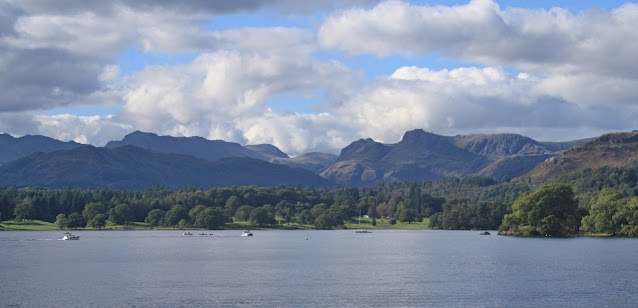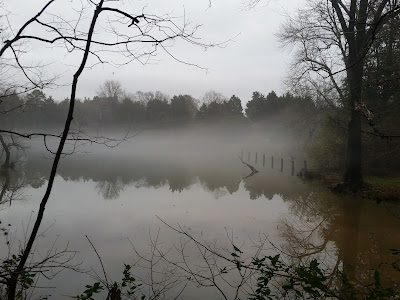This week, in the run-up to Hallowe’en, BGS is offering you some SPOOOOOOOKY stories from ghastly geological spots around the UK. Read and shiver as we uncover some terrifying tales and - when you can - visit the spots yourself to find ghosts and ghouls whilst taking in the beautiful local scenery.
Our first set of tales take in waterways, from pools to lakes via sprites and mermaids. We can’t claim to know the truth of these tales but our hydrogeologists have definitely seen a sight or two, working in remote watery spots.
Deil’s Cauldron, Perth & Kinross
 |
| The Deil's Cauldron ©markintellect |
If you want to take in some spectacular views while you take in a spooky site then the 4-5 mile round trip to the Deil’s Cauldron just outside of Comrie in Perth & Kinross is a great bet.
The Deil's Cauldron is a narrow river gorge in the Ben Ledi Grit Formation, a metamorphosed sandstone of latest Precambrian-earliest Cambrian age, located in central Scotland. The fast river flows to a group of deep, dark pools.
Living in the pools is a water elf called Uris-chidh. The elf gets lonely, so he sets out to find a companion by playing a compelling tune on his pipe, luring people into the pools to their death. So if you’re around the pools and hear Uris-chidh’s tune, remain vigilant and remember the only ones who live to tell the tale are the ones who ignore his music.
The Silent Pool, Surrey
 |
| The Silent Pool, 1916 ©British Geological Survey |
Said to be the most haunted body of water in the country, this spring-fed idyllic Silent Pool in Surrey hides some spooky secrets. It is probably the remains of an old chalk quarry the spring comes from a base of chalk and creates the beautiful bluish green colour of the pool.
The Silent Pool is purported to be haunted by Emma, the ghost of a woodcutter’s daughter, murdered by King John who approached her on horseback while she was bathing in the pool, not leaving her alone until she had to retreat so far into the water she drowned. King John did not attempt to save her, and a feather from his hat left at the scene of the crime implemented him in the murder. People still claim to see the ghost of Emma floating above the pool at midnight, or hear the beating of hooves as a rider is seen loitering nearby.
Most interestingly, the pool is also part of the mystery surrounding Agatha Christie’s disappearance in 1926. One morning Agatha’s car was found abandoned at the pool, which was promptly dredged. No sign of Christie was found, but that was probably because she was hiding out at a nearby hotel and found safe and well eleven days later.
The White Horse of Windermere
 |
| Lake Windermere |
As far as hauntings are concerned, the White Horse of Windermere is actually quite nice. If trouble is about to befall the neighbourhood of Windermere then a beautiful white horse is said to wander across the lake as a sign of warning.
The spirit is said to be the spirit of a monk, who took it upon himself to save fair maidens from peril.
Mermaid’s Pool, The High Peaks
 |
| The Mermaid's Pool © Neil Theasby |
You might be surprised to find that a landlocked area has mermaids but myth and magic work in mysterious ways.
In the High Peaks between Kinder Downfall and Kinder Low, adventurers can find the small, eerie-looking Mermaid’s Pool, a salinated body of water, which is odd as it’s located inland.
Thought to be a pre-Christian place of worship, according to more recent legend if you visit at Easter and look into the waters at sunrise you will see the mermaid. She can grant immortality, but only if she likes the look of you. If not, you’ll be lured to your death. Year-round the pool is supposed to exude a feeling of dread and foreboding.
Another tale tells of a cursed charm, which caused chaos in the nearby village of Hayfield in 1760. A vicar was called to perform an exorcism on the charm, which flew into the pool and remains there to this day.
Birds won’t fly over the pool, nor will animals drink from it. The latter makes sense as the pool is indeed salinated, one suggestion that it is connected to the sea by an underground tunnel – maybe that’s how the mermaid gets to the sea and back? We couldn't possibly comment.
The views all around this location are gorgeous, though be careful when walking nearby, as it’s rather boggy.
Glaslyn Lake, Snowdonia
 |
| A view from near the summit of Snowdon, looking East to Llyn Glaslyn and Llyn Llydaw © British Geological Survey |
Perhaps one of the most pervading UK folklore tales is that of Arthur and his knights. Glaslyn Lake – stained green from a high concentration of copper ore – in Snowdonia, Wales is the setting of one of the most exciting stories in the Arthurian legend.
As the tale goes, when Arthur was killed at Bwlch y Saethau (The Pass of Arrows) one of his knights, Sir Bedivere threw Arthur’s legendary sword, Excalibur, into a nearby lake which was then claimed by the Lady of the Lake. The lake itself is of course believed to be Glaslyn.
In 2017 more depth was added to the Lady of the Lake story, as a 6th century sword was found at a nearby site – Llyn Ogwen – giving credence to the story of Arthur’s lost blade.
Another myth of Glaslyn is that the Welsh water beast Afanc was relocated underneath the lake by angry villagers, as it was causing too much trouble in its River Conwy lair.
River Ribble by Waddow Hall, Lancashire
 |
| The weir at Waddow Hall ©Alexander P Kapp |
Peg O’Nell is Lancashire’s resident water sprite. She came to the role in a different way to most sprites however, originally being a servant girl at Waddow Hall.
According to the tales, one day Peg fell out with her Mistress because she didn’t want to fetch any water from the nearby well. Her mistress dismissed her with a shout of ‘I hope you fall and break your neck!’ With that, Peg was never seen alive again: after slipping on some ice and falling into the River Ribble, she broke her neck and was carried away by the strong current. Peg transformed into a water sprite is said to now haunt the river, demanding a human is sacrificed to appease her once each seven years, which also prevents her incessant screaming. Peg can be assuaged by the sacrifice of an animal instead, which is benevolent of her, we’re sure you’ll agree.
The potential ‘well’ of the story is close by in Clitheroe, and is dedicated to Peg, adorned with a statue of her. Peg’s mistress was so unhappy with the statue and continuing bad luck attributed to Peg that she chopped off the head of the statue, which remains headless to this day.
In another version of the Peg O’Nell story, Peg was simply a sprite who caused a local preacher to fall into the river and drown. The statue of Peg lost its head as punishment.
We always love a spooky tale! Do you have any geological stories of ghosts and ghouls? If so, let us know about them in the comments!


Comments